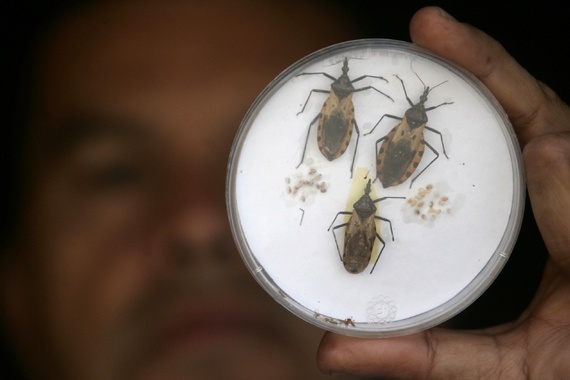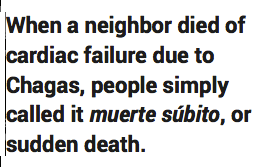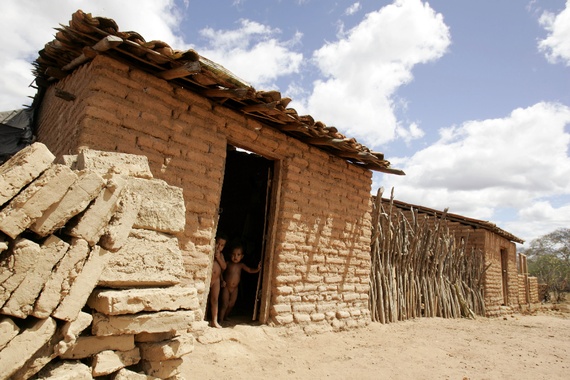
(above) Triatomines, or "kissing bugs," transmit the Chagas parasite via painless bites. (Edgard Garrido/Reuters)
Northern Virginia: 'Ground Zero' for Kissing Bug Disease
July 24, 2014 - theatlantic.com
Chagas, a disease common in Latin America, is gaining traction among immigrants in the U.S.
by Daisy Hernández
When Jenny Sanchez was pregnant, she asked her doctor in Virginia to test her for Chagas, also known as the "kissing bug disease." She was worried about passing it onto her son and putting him at risk for heart failure one day. In Bolivia, where she was born and raised, expectant mothers were routinely screened for Chagas, but her American doctor had never heard of it.
"I thought maybe I was saying it incorrectly," says Sanchez, a 44-year-old microbiologist for whom English is a second language.
But once Sanchez succeeded in communicating, the doctor told her to not worry. Chagas is transmitted by triatomine insects endemic to Latin America, not Virginia. Sanchez, however, knew the disease could live in the body for decades without producing any symptoms and could be passed from mother to child.
After giving birth to her son in 2002, Sanchez returned to Bolivia and was tested. The results were negative, but the experience got her thinking: How many other immigrant mothers—not to mention grandmothers, husbands, brothers and children—were living in Virginia without knowing if they had the deadly disease? After all, Bolivia has the highest rates of Chagas disease in the world, according to the Drugs for Neglected Diseases Initiative, and estimates from the U.S. Census Bureau show that Virginia is home to more Bolivians than any other state in the country, including California and New York combined.
As it turned out, the first documented case in the United States of a mother transmitting Chagas to her baby would eventually happen in Northern Virginia in 2010.
The number of people with Chagas disease just outside the nation's capital is small—about two dozen cases, according to interviews with local physicians—but doctors and experts say they wouldn't be surprised if the numbers were higher. Doctors, unfamiliar with the disease, are not routinely screening for it, and many patients tend to be undocumented immigrants without health insurance. While Chagas doesn't pose a risk to the general population in the U.S., patient advocates, like Sanchez, believe the disease continues to be ignored because of its connections to poverty and immigration.
* * *
According to the World Health Organization, an estimated 8 million people have Chagas disease worldwide, most of them in Latin America. The triatomines, or the so-called kissing bugs, live in the cracks of walls in rural houses made of mud and thatched roofs and they bite people at night, passing the parasite through their feces. The bite itself is painless, and many people never show any signs of the disease. A third of those with Chagas, however, develop heart disease or megacolon, and untreated, they die from what appear to be sudden heart attacks. An estimated 11,000 people lose their lives every year to the disease, according to the WHO.
Because of migration, patients with Chagas are showing up everywhere from Spain and Italy to Japan and Australia. The Centers for Disease Control and Prevention estimates that 300,000 people are infected with Chagas in the U.S. A clinic devoted to diagnosing and treating the disease opened at Olive View-UCLA Medical Center in Los Angeles in 2007, and, according to the CDC, doctors in New York City and Georgia are screening patients who might have been exposed to the disease in their countries of origin.
Dr. Rachel Marcus, a cardiologist, believes Northern Virginia could be "ground zero" for Chagas disease, because of the volume of immigrants from Bolivia, where the disease is endemic. In 2012, she gave up her private practice to focus on patients with Chagas disease. If colleagues thought she would never find a patient with a tropical disease near the Beltway, they were wrong.
Marcus took a job at a cardiac ultrasound lab after leaving her practice, and one of the first patients to walk through her door was an immigrant who needed a heart transplant. He was from Brazil and told her the kissing bug was prevalent in his hometown. When Dr. Marcus looked at his EKG, she knew he had Chagas.
"If you were to find that EKG from an area where Chagas is common, it's diagnostic," she said. American doctors, however, had never made the connection. She sent his lab results to the CDC, which confirmed that the patient had Chagas.
According to Dr. Susan Montgomery, who leads the epidemiology team at the CDC, American doctors started to hear about Chagas disease in 2007 when blood banks in the U.S. began screening for it and sending people letters informing them that they had tested positive and should see their physicians. Health care providers started contacting the CDC and they haven't stopped. In a ranking of the common phone inquiries the CDC receives, "Chagas disease is always number two every single month," Montgomery said.
In 2010, one of those calls came from Northern Virginia. Pediatric infectious disease doctors there were seeing an unusual parasite in the blood smears of a baby who'd been born prematurely. The mom was a 31-year-old woman from Bolivia, and the baby, who'd been born at 29 weeks, weighed slightly more than 4 pounds. He seemed to be fighting an infection, and doctors assumed it was sepsis and treated him with antibiotics. Then they saw the parasite and talked with the mom. In Bolivia, expectant women are usually tested for Chagas, and yes, she remembered. With her previous pregnancy, she'd been told she had Chagas.

"It's not something that we think of asking right away," said Dr. Julie-Ann Crewalk, one of the pediatricians from the private practice that handled the case. She and her colleagues have only had two diagnoses of children with Chagas, but, she said, "I wouldn't be surprised if the numbers were higher and we're just not seeing it."
The newborn was treated for Chagas with medications distributed by the CDC, and by his first birthday, he was considered cured. Crewalk doesn't know about the mother. While the CDC provides medication for free, it doesn't have a curative effect for adults with chronic Chagas, and it's hard, if not impossible, for moms with Chagas and no health insurance to see the doctors who would connect them to the CDC.
Sanchez decided to take action two years ago, believing that Chagas screening should be routine for expectant women from endemic countries—and everyone else. She talked to Doctors Without Borders and researchers of the disease, and eventually found Marcus. Last year, the two women began screening patients through the Bolivian consulate's mobile health clinics.
In an initial screening of 66 patients, 29 percent of them tested positive for the disease. "If you took people from endemic areas like Santa Cruz and Cochabamba [in Bolivia], 50 percent were positive," Marcus said.
One of those patients who tested positive was Sanchez's own 69-year-old mother, María, who lives with Sanchez and her two children in northern Virginia.
* * *
María Frerkinj grew up in the city of Santa Cruz, Bolivia, and she spent three months every year out in the countryside, where the kissing bugs, known as vinchucas in her country, lived in the cracks of houses made of mud and sticks. The moment the lights were turned off at night, the insects would run out from the crevices, but, María recalled that "people would say, 'That bug doesn't do anything.'" No one there knew about the connection to Chagas. When a neighbor or family member died of cardiac failure due to Chagas, people simply called it muerte súbito, or sudden death.
(below) Kissing bugs live in the walls of mud houses in rural Latin America, emerging at night to bite their victims. Bruno Domingos/Reuters

A grandmother, María says she has times now when she feels her chest tighten for a few moments, and then it passes and her heart starts beating faster than usual. She needs an echocardiogram but doesn't have health insurance, which Marcus said is the case for the majority of her patients with Chagas. Marcus is herself working with a donated EKG machine and has often paid out of pocket for lab work that can run up to $225 a patient.
Dr. David Wheeler, an infectious disease specialist in Northern Virginia, has seen about six or eight patients with Chagas disease in the last couple of years. He describes them as "Bolivian women in their 40s" who are otherwise healthy. Aside from a lack of insurance, the other problem, he says, is that patients don't necessarily have savings in case they have adverse reactions to the medication and can't work. One of Wheeler's patients delayed treatment for a month. "She wanted to clean some more houses so she could save more money," he said.
The standard medication for Chagas is benznidazole. While it often cures young children and patients who have recently contracted the parasite, the results have been mixed for chronic adult patients. Some patients develop severe skin rashes, and Marcus said, "Everyone gets side effects," including nausea. The drug ultimately only helps between 15 and 35 percent of the patients who take it, according to researchers, though a study published in the New England Journal of Medicine in May found that it was still more effective than an anti-fungal drug that had showed promise.
Marcus has suspended treating patients with benznidazole until the fall, when the results of a 10-year study of the medication are released. The World Health Organization is one of the study's sponsors.
Dr. Felipe Guhl, a molecular biologist at the University of the Andes in Bogotá, has been studying Chagas for 35 years and his team has been working on that 10-year study. In 1997, Guhl and his colleagues found the parasite responsible for Chagas in 4,000 year old mummies from the Atacama Desert in Chile. "The parasite is very successful. It's been able to live with an enormous number of animals for millions of years," Guhl said, adding that he's enthusiastic about the benznidazole study. "It's going to shed a lot of light on how effective the treatment is for adults with chronic Chagas."
The FDA has not approved benznidazole for use in the U.S. Physicians like Marcus and Wheeler have to send patients' blood samples to the CDC for diagnosis, and officials there provide free doses of benznidazole under investigational protocols. Marcus has been making house calls to dispense the medication to patients, and Wheeler was recently trying to track down his patient who had delayed treatment so she could increase her savings.
All these factors—Chagas patients' lack of insurance, benznidazole's side effects, and the need to go through the CDC—leave hospitals and clinics with little incentive to screen or treat Chagas patients, according to Marcus.
This pains Sanchez, who worries constantly now about her own mother and the many other people in her community who need to be screened. "People want to do the test," Jenny says. At the Bolivian health clinics, people have said to her, "Chagas? Oh, yes, my tío has it. My abuela has it."
Sanchez and Marcus have created the Latin American Society of Chagas, a Washington, D.C.-area group to advocate for screening, and they are turning their fledgling organization into an official nonprofit that can receive donations and grants. Last November, they testified on a Chagas panel at the Pan American Health Organization headquarters in D.C.
Both women are hoping that the CDC and public health departments in Virginia and across the country will do more to encourage testing, especially among immigrants from regions where the disease is endemic. According to Marcus, patients don't have to start medication right away, but at least they will know that they need to have their hearts monitored frequently.